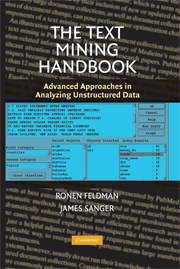Book contents
- Frontmatter
- Contents
- Preface
- I Introduction to Text Mining
- II Core Text Mining Operations
- III Text Mining Preprocessing Techniques
- IV Categorization
- V Clustering
- VI Information Extraction
- VII Probabilistic Models for Information Extraction
- VIII Preprocessing Applications Using Probabilistic and Hybrid Approaches
- IX Presentation-Layer Considerations for Browsing and Query Refinement
- X Visualization Approaches
- XI Link Analysis
- XII Text Mining Applications
- Appendix A DIAL: A Dedicated Information Extraction Language for Text Mining
- Bibliography
- Index
I - Introduction to Text Mining
Published online by Cambridge University Press: 08 August 2009
- Frontmatter
- Contents
- Preface
- I Introduction to Text Mining
- II Core Text Mining Operations
- III Text Mining Preprocessing Techniques
- IV Categorization
- V Clustering
- VI Information Extraction
- VII Probabilistic Models for Information Extraction
- VIII Preprocessing Applications Using Probabilistic and Hybrid Approaches
- IX Presentation-Layer Considerations for Browsing and Query Refinement
- X Visualization Approaches
- XI Link Analysis
- XII Text Mining Applications
- Appendix A DIAL: A Dedicated Information Extraction Language for Text Mining
- Bibliography
- Index
Summary
DEFINING TEXT MINING
Text mining can be broadly defined as a knowledge-intensive process in which a user interacts with a document collection over time by using a suite of analysis tools. In a manner analogous to data mining, text mining seeks to extract useful information from data sources through the identification and exploration of interesting patterns. In the case of text mining, however, the data sources are document collections, and interesting patterns are found not among formalized database records but in the unstructured textual data in the documents in these collections.
Certainly, text mining derives much of its inspiration and direction from seminal research on data mining. Therefore, it is not surprising to find that text mining and data mining systems evince many high-level architectural similarities. For instance, both types of systems rely on preprocessing routines, pattern-discovery algorithms, and presentation-layer elements such as visualization tools to enhance the browsing of answer sets. Further, text mining adopts many of the specific types of patterns in its core knowledge discovery operations that were first introduced and vetted in data mining research.
Because data mining assumes that data have already been stored in a structured format, much of its preprocessing focus falls on two critical tasks: Scrubbing and normalizing data and creating extensive numbers of table joins. In contrast, for text mining systems, preprocessing operations center on the identification and extraction of representative features for natural language documents.
- Type
- Chapter
- Information
- The Text Mining HandbookAdvanced Approaches in Analyzing Unstructured Data, pp. 1 - 18Publisher: Cambridge University PressPrint publication year: 2006
- 2
- Cited by



